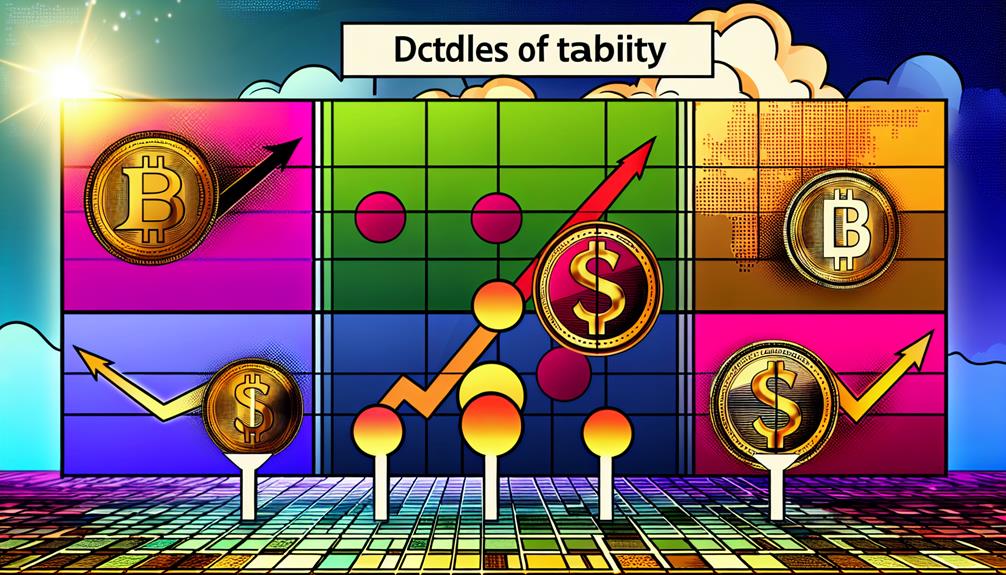Like a ship steering through foggy waters, USDT offers a stable refuge in the often tumultuous seas of cryptocurrency. Yet, you might wonder about the hidden dangers lurking beneath its surface. Concerns about transparency, regulatory scrutiny, and the adequacy of asset backing create a complex picture of this widely used stablecoin. Understanding these factors is essential if you're considering USDT as a safe option for your investments. What exactly should you be aware of before making a decision?
Overview of USDT

When considering the landscape of cryptocurrencies, Tether's USDT stands out as one of the most widely used stablecoins. It's designed to maintain a value pegged to the U.S. dollar, which appeals to traders and investors seeking stability in a notoriously volatile market. USDT usage has surged over the years, primarily due to its ability to facilitate trading across various cryptocurrency exchanges, allowing users to convert their digital assets into a stable form without the complexities of fiat transactions.
In the USDT market, you'll find that it serves several important roles. First, it acts as a liquidity tool, enabling traders to transact quickly without needing to convert their holdings back to fiat currency. This is particularly advantageous in times of market volatility, where rapid trades can capitalize on price fluctuations. Additionally, USDT is often used as a medium for transferring value between exchanges, making it easier for users to take advantage of arbitrage opportunities.
Despite its popularity, the USDT market faces scrutiny regarding its transparency and backing, which can affect users' confidence in its stability. Nevertheless, the demand for USDT remains robust, evidenced by its high trading volumes and widespread acceptance across various platforms. Understanding USDT's role in the cryptocurrency landscape can help you navigate the complexities of digital currency trading while mitigating some of the inherent risks associated with more volatile assets.
How USDT Is Backed
Understanding how USDT is backed is vital for evaluating its stability and reliability as a stablecoin. Tether claims that each USDT is backed by a reserve of assets, which are intended to guarantee that the stablecoin maintains its peg to the US dollar. These Tether reserves include fiat currencies, cash equivalents, and other assets that contribute to its overall value.
The issuance process is significant, as it dictates how new USDT tokens enter circulation. For every USDT issued, an equivalent amount of fiat or assets should ideally be deposited into Tether's reserves. However, liquidity concerns arise if there are doubts about whether Tether can meet redemption requests during market fluctuations. Users need to know that they can convert their USDT back into fiat or other assets without significant delays.
Asset transparency is a hot topic among critics and supporters alike. Tether has made efforts to improve its auditing practices, yet skepticism remains about the true nature and composition of its reserves. Regular audits could enhance trust in the backing of USDT, but the current practices are often seen as insufficient.
In terms of market stability, the ability to redeem USDT for fiat backing can help mitigate price volatility. This is especially important during times of market stress, where the demand for liquidity can spike. Understanding these factors can help you make informed decisions regarding USDT and its role in the cryptocurrency landscape.
Regulatory Compliance Issues

When considering USDT's safety, regulatory compliance issues are essential. You'll want to examine the current regulatory framework, recent legal challenges, and what future compliance might look like. Each of these aspects can greatly impact USDT's stability and your investment decisions.
Regulatory Framework Overview
How does the regulatory landscape impact the safety of USDT? The evolving regulatory framework is essential in shaping its safety profile. Regulatory changes can create compliance challenges for USDT, especially as jurisdictions tighten their oversight on digital assets. This increased scrutiny may lead to enforcement actions against entities failing to meet compliance requirements, causing potential disruptions in the USDT market.
International regulations also play a significant role. Different countries may adopt varying transparency standards and auditing practices, complicating USDT's ability to operate seamlessly across borders. If a country imposes strict regulations, it could impact USDT's liquidity and accessibility, possibly diminishing user confidence.
Moreover, the adherence to consumer protection laws is paramount. As regulators focus on safeguarding users, USDT must align with these standards to maintain its reputation and user trust. Any failure to comply could lead to legal repercussions and further market impact, raising questions about its overall safety.
Recent Legal Challenges
As legal challenges continue to mount, USDT faces increasing scrutiny regarding its regulatory compliance. The ongoing investigations and lawsuits have significant legal implications for Tether, the company behind USDT. These actions not only question the legitimacy of USDT's reserves but also challenge its overall operational framework. Regulatory bodies are keenly examining whether Tether's practices align with existing financial laws, which can lead to potential fines or operational restrictions.
Market reactions to these legal challenges have been mixed. Some investors express concern, causing fluctuations in USDT's value and its market stability. Others view these challenges as an opportunity, believing that a clearer regulatory framework could enhance the long-term viability of stablecoins like USDT. However, the uncertainty surrounding regulatory outcomes may deter new investors and influence trading volumes negatively.
Furthermore, the implications of non-compliance could resonate beyond Tether, affecting the broader cryptocurrency market. As regulatory bodies tighten their oversight, the future of USDT hinges on how effectively it navigates these legal challenges. In this environment, staying informed about USDT's compliance efforts is essential for anyone involved in the crypto space.
Future Compliance Outlook
Maneuvering the evolving landscape of regulatory compliance poses significant challenges for Tether and USDT in the coming years. As regulatory bodies worldwide tighten their grip on cryptocurrencies, you're likely to see future trends that demand greater transparency and accountability from stablecoin issuers. Tether must adapt swiftly to these changes to maintain its market position and user trust.
One of the prominent compliance challenges is the varying regulations across jurisdictions. Countries like the U.S. are increasingly scrutinizing stablecoins, requiring stricter compliance with anti-money laundering (AML) and know-your-customer (KYC) regulations. If Tether fails to align with these requirements, it could face legal repercussions and potential loss of operational capabilities.
Moreover, the introduction of new regulatory frameworks could lead to increased operational costs and necessitate technological upgrades. You'll also need to take into account the potential for evolving public sentiment towards stablecoins, which could influence regulatory approaches. Fundamentally, Tether's future hinges on its ability to navigate these compliance challenges effectively while anticipating regulatory shifts, ensuring that USDT remains a viable option in a rapidly changing financial landscape.
Risks of Holding USDT
When considering the risks of holding USDT, it is crucial to evaluate both market volatility and regulatory uncertainty. While USDT is designed to be a stablecoin, its value can still be influenced by fluctuations in the broader cryptocurrency market. This means that during periods of high market volatility, the perceived stability of USDT could be challenged, leading to potential price discrepancies.
Another significant risk is liquidity concerns. Although USDT is widely used, there may be times when liquidity is restricted, especially during market downturns or extreme volatility. If you need to convert your USDT back to fiat currency or another cryptocurrency, you might find it difficult to do so without incurring substantial losses. This is particularly critical if you're relying on USDT as a safeguard against price swings in other cryptocurrencies.
Moreover, regulatory uncertainty poses additional risks. As governments and regulatory bodies worldwide continue to scrutinize cryptocurrencies, changes in regulations could impact USDT's acceptance and usability. If restrictions are imposed, it could affect the market's perception of USDT, potentially leading to a decline in demand.
Comparing USDT With Other Stablecoins

Given the risks associated with holding USDT, it's important to compare it with other stablecoins to assess its relative safety and functionality. USDT, while widely used, has faced scrutiny regarding its reserves and transparency. Other stablecoins like USDC, DAI, and BUSD may provide alternatives that could mitigate some of the USDT volatility.
Here's a concise comparison of these stablecoins based on key factors:
| Stablecoin | Backing Asset |
|---|---|
| USDT | Fiat-backed |
| USDC | Fiat-backed |
| DAI | Collateralized |
| BUSD | Fiat-backed |
| TUSD | Fiat-backed |
When considering market sentiment, USDC and BUSD have generally maintained stronger reputations due to higher transparency and regulatory compliance. This can lead to more stability during periods of market volatility. In contrast, USDT has experienced fluctuations in trust, which can exacerbate its volatility during bearish market conditions.
DAI, being a decentralized stablecoin, offers unique advantages, though it relies on collateralized assets that can be subject to price swings. The level of decentralization might appeal to those wary of centralized entities, impacting their market sentiment.
Best Practices for Using USDT
When using USDT, selecting a secure wallet is essential to protect your assets from potential threats. Additionally, regularly monitoring your balance helps you stay informed about any discrepancies or unauthorized transactions. Finally, implementing thorough transaction verification practices guarantees that every transfer is legitimate and minimizes the risk of fraud.
Secure Wallet Selection
Selecting a secure wallet for storing USDT is essential to safeguarding your assets. To make an informed choice, you should consider the different types of wallets available. Hardware wallets, for instance, offer a high level of security by storing your private keys offline, minimizing the risk of hacks. On the other hand, software wallets are more convenient for daily transactions but may expose you to security vulnerabilities if not managed properly.
Implementing multi-signature security can enhance your wallet's safety by requiring multiple approvals for transactions. This adds an extra layer of protection against unauthorized access. Additionally, focus on wallet recovery options; confirm that the wallet you choose provides a straightforward recovery process in case of loss or theft.
Effective private key management is critical—never share your private keys, and store them securely. Wallet encryption is another important aspect; make certain your wallet offers robust encryption to protect your assets from potential breaches. By carefully selecting a wallet that emphasizes these features, you'll greatly reduce the risk associated with storing USDT, ultimately providing peace of mind in your digital asset management strategy.
Regular Balance Monitoring
Monitoring your USDT balance regularly is vital, as it helps you stay informed about your financial position and detect any discrepancies early. This practice not only enhances your awareness of account activity but also allows you to set up balance alerts for significant changes. By doing so, you can react promptly to unauthorized transactions or potential fraud.
Here's a quick reference table to guide your monitoring strategy:
| Frequency | Action |
|---|---|
| Daily | Check your balance and account activity. |
| Weekly | Review transaction history for unusual activities. |
| Monthly | Set balance alerts and assess overall financial health. |
Establishing a routine for these checks can mitigate risks associated with holding USDT. If you notice any unusual fluctuations or discrepancies, it's important to investigate immediately. Additionally, using tools that provide real-time updates can further enhance your monitoring efforts. By prioritizing regular balance monitoring, you're not just protecting your assets; you're also ensuring that you remain in control of your financial situation.
Transaction Verification Practices
Ensuring the integrity of your transactions is essential when using USDT, as any oversight could lead to potential losses or complications. To safeguard your assets, it's vital to adopt effective transaction verification practices. Start by choosing a reliable exchange with a strong reputation for transaction speed and security. Slow transaction speeds can be a red flag, as they may indicate underlying issues with the platform.
When executing transactions, utilize robust verification methods. Two-factor authentication (2FA) adds an extra layer of security, ensuring that even if someone acquires your login credentials, they won't easily access your account. Always confirm the recipient's address before sending USDT; a simple typo can lead to irreversible loss.
Additionally, consider implementing transaction limits to minimize potential losses in case of fraud. Regularly review your transaction history for any unauthorized activity. Familiarize yourself with the platform's security features, including withdrawal whitelists, which can further protect your funds.
Frequently Asked Questions
What Happens if Tether Goes Bankrupt?
If Tether goes bankrupt, you'd likely see significant market implications, affecting cryptocurrencies' stability. Investors might panic, leading to a sell-off and increased volatility, which could shake confidence in stablecoins and impact overall market health.
Can USDT Be Hacked or Stolen?
USDT can potentially be hacked or stolen, but its security measures, including robust encryption and theft prevention protocols, greatly reduce these risks. However, you should always practice caution and use secure wallets for your assets.
Is USDT Accepted by All Exchanges?
While USDT's adoption has skyrocketed, it's not accepted by every exchange due to varying USDT regulations. Some platforms prefer other stablecoins, so always check each exchange's supported currencies before trading.
How Can I Convert USDT to Cash?
To convert USDT to cash, you can use various conversion methods like peer-to-peer exchanges or crypto ATMs. For cash withdrawal, verify the platform supports your local currency and check for any associated fees.
Are There Fees for Using Usdt?
When you're diving into USDT transactions, you'll encounter transaction costs that can vary. Additionally, many exchanges impose withdrawal fees. It's crucial to analyze these expenses carefully to avoid unexpected surprises during your cash conversion process.
Conclusion
In summary, while USDT offers a practical solution for trading in the volatile cryptocurrency market, its safety isn't guaranteed. With over 70% of all cryptocurrency trades involving USDT, its liquidity is undeniable. However, the concerns surrounding its backing and regulatory compliance should give potential investors pause. Always weigh the risks and consider alternatives like USDC or DAI, which may offer greater transparency. Remember, informed decisions are key to steering through the complexities of cryptocurrency investments effectively.
